Original URL: https://www.theregister.com/2013/11/11/review_raspberry_pi_fuze_case_and_kit/
RETRO-GASM: The Fuze electronics kit for the Raspberry Pi
Electronics! Metal! Screws! Resistors! Buzzers! Basic programming! Nostalgia!
Posted in Personal Tech, 11th November 2013 11:46 GMT
Review Back in the day of the board computers of the late 1970s - your Scrumpi, your Nascom 1, your UK-101 et al - it was customary to build a case for it out of wood. If you were a better equipped "constructor" - what we used to call "makers" in those days - you’d build a box out of metal.
Folk like Tangerine offered optional cases, but most home micros made do with homemade jobs or nothing at all. Then along came the pre-knighthood Sir Clive Sinclair with his ZX80, and home micros had to be clad in plastic from then on.
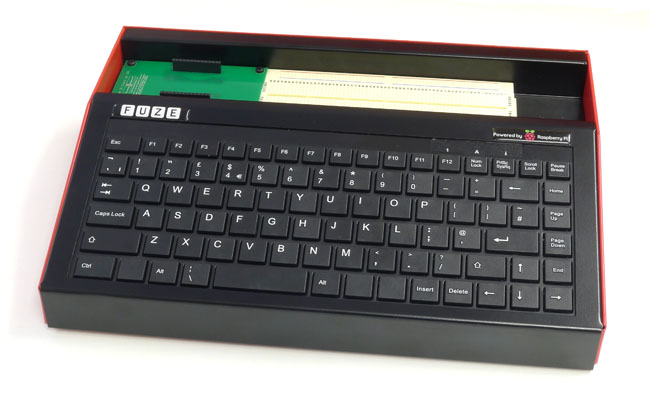
Fuze: very metal
Skip forward 30-odd years and history is repeating itself. The Raspberry Pi is a board computer just like those 1970s offerings, only more powerful, more compact and with better programming facilities than the machine code monitors of yore. Some people even make their own cases, though there’s no shortage of plastic off-the-shelf offerings.
And then there’s the Fuze, which takes Pi packaging to a whole new level of functionality - and of blast-from-the-past retro-styling.
The Fuze is, quite simply, a large, keyboard-equipped case for the Pi that’s aimed less at kids learning to code - though it’s still perfect for that role too - than at hardware hackers who want to use the tiny computer as a microcontroller for electronics projects.
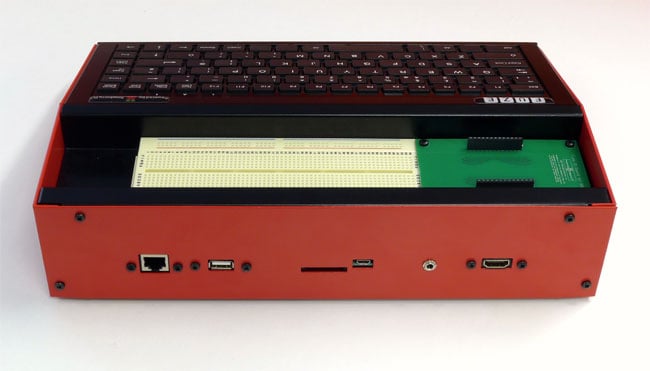
A more convenient organisation of the Pi’s ports
The whole thing looks a late 1970s/early 1980s micro. It’s a large, metal box with full-size chiclet-style keyboard built in and mounted at an angle to give it more of a rake than most external keyboards are able to provide these days. Round the back is a line of ports, each accessed through a hole in the metal case and held tightly in place with a pair of cross-head screws.
Two of them – the SD slot and a micro USB port – are those mounted on the Pi itself, but the rest – HDMI, 3.5mm audio, one full-size USB, and 10/100Mbps Ethernet – are separate connectors, linked up to the board by internal extension cables. You’ll note there’s just a single USB port on the back, not because the Pi inside is a Model A, but because the Pi’s second USB port is connected to the keyboard.
The case is constructed from a set of three folded and painted – in red and black, natch – steel plates: the base and sides; a rear panel with an interior tray to which the Pi is fixed; and an upper section with a gap for plastic keyboard. Four small, self-adhesive rubber feet stop the Fuze from sliding around.
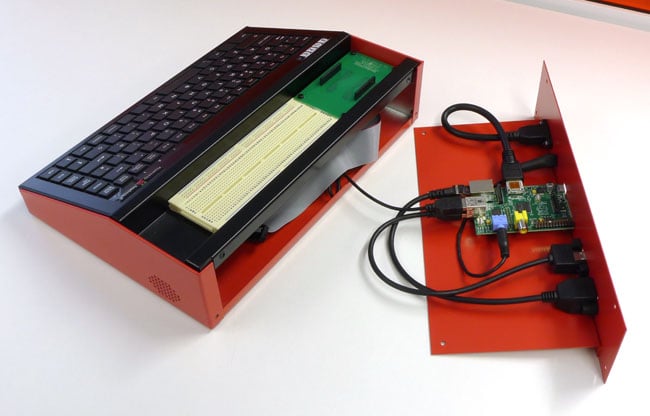
Once there might have been a Science of Cambridge MK14 inside, now it’s a Raspberry Pi
It’s reasonably well made. It could probably do with a couple more screws on the back to hold the upper sections together more tightly, and there are some exposed edges - not sharp, though - which aren’t very (young) child-friendly.
That said, it’s sufficiently robust for a life in Bash Street, so it’s something of a no-brainer for teachers seeking a way of keeping Pis intact and safe from poking fingers.
Above the keyboard is an inch-deep recess into which the Fuze’s creator, Binary Distribution, has fitted a GPIO breakout board comprising two, widely spaced female connectors ready for jumper wires, and a long plastic breadboard ready for your prototypes.
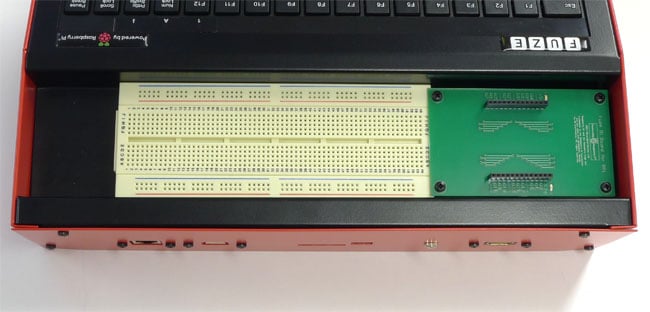
Solderless breadboard and GPIO breakout built in
Like one of those electronics project kits some of us as kids got for Christmas many years ago, the Fuze comes bundled with an plethora of resistors, coloured LED lamps, micro-switches, a buzzer and a single-character seven-segment LED display and jumper wires ready for connection. They’re all neatly placed in a small, multi-compartment plastic case.
Back to Basic
It gets better. Inside the case you’ll also find a 4GB SD card pre-loaded with an OS that boots straight to the desktop and guides you to - get this - a Basic interpreter. So even if you’re not particularly interested in electronics, you can spend endless hours reliving your youth by hacking away in Basic.
Well, almost. While many of Fuze Basic’s functions and commands will be instantly familiar to forty-something folk, it’s a modern dialect that borrows plenty from later languages, but includes plenty of old stuff too.
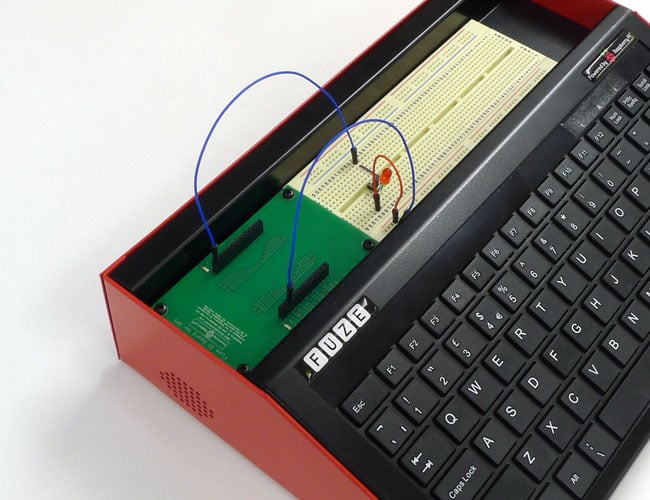
Today, a few LEDs, wires and switches; tomorrow, THE WORLD
There are line numbers and even GOTO or GOSUB commands, but there seems an emphasis, particularly in Fuze’s Project Cards - a decent, PDF-based Basic learning resource - on using DEF PROC, familiar to BBC Micro owners, to define subroutines instead. All without line numbers.
It’s a curious mix. The EDIT command calls up a full-screen editor, into which you can enter code without line numbers. But to key in a program at the command prompt, as we used to back in the day, and you do need line numbers. Enter LIST and you’ll see line numbers added, though they’re absent when you go back to the editor.
It would be churlish to complain about this apparent inconsistency. Consider it a way of keeping the old-style Basic buffs happy while simultaneously steering newcomers toward a more modern way of coding with functions.
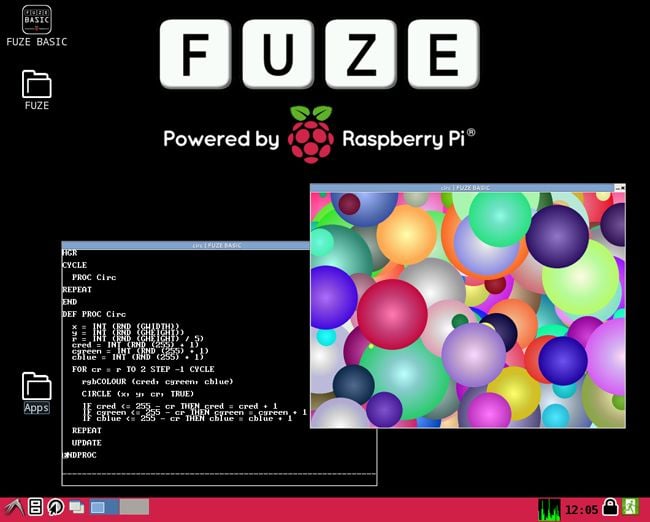
Fuze boots straight to the desktop
This allows structures like IF... THEN... ELSE can stretch over multiple lines, with indentation used to mark out sections, the way they do in languages such as C and Python. C’s SWITCH... CASE syntax has been added too. Some of the graphics commands come straight from the likes of Logo.
FOR is no longer accompanied by NEXT but by REPEAT, which flings the program counter back the start of the start of the loop mechanism for which Fuze Basic adds a new command, CYCLE, to the familiar WHILE and UNTIL, though because these are used at the start of the loop there’s no need for DO.
But most of the classic Basic commands and functions – CLS, DATA, DIM, LET, LIST, LOAD, PRINT, READ, REM, RESTORE, RUN, SAVE; CHR$, LEN, MID$, PLOT, RND, STR$ – are all present and usable as you’d expect.
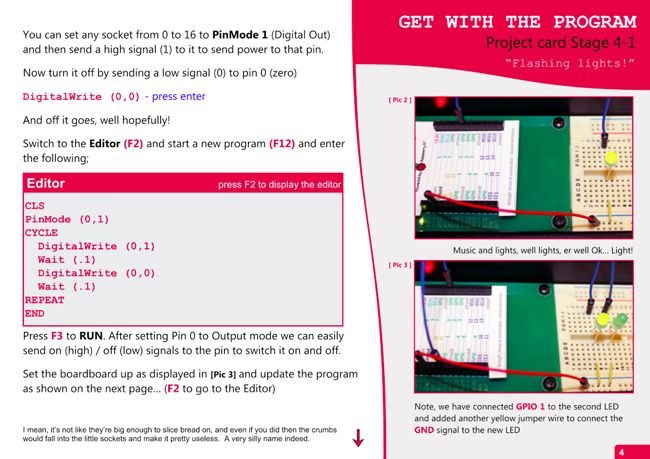
Fuze’s Project Cards provide a Basic tutorial
Fuze Basic is a commercial version of Gordon Henderson’s Return to Basic interpreter. If you’ve used the popular WiringPi system, you’ll be familiar with Gordon’s work. He promises to retrofit the features available in Fuze Basic, which is essentially RTB 2.0, into RTB, which is currently at version 1.0.4. Gordon has a more detailed reference guide here; the one bundled with Fuze is essentially just a list of commands and syntax.
The WiringPi connection is handy, because it means Fuze Basic is ready equipped with a number of GPIO-related commands for reading and writing to specific pins, both digital and analog. That allows you do control electronics projects prototyped on the Fuze’s breadboard right in Basic.
I’d also have liked to see the GPIO breakout board marked with more information than pin numbers. It really should make clear which are the I2C, UART, SPI and CLK pins, for instance. There is an overlay card with colour-coded pin information included, but it lacks a key to those colours. I know what they all are, but a newcomer won’t.
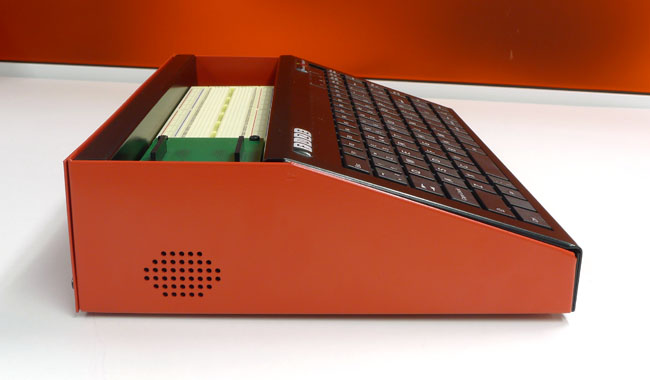
Old-style holes-in-the-case ventilation
The Reg Verdict
Merely as a Pi-less case, the Fuze will set you back £70; £90 if you get it with the breadboard and a PSU too. Pay £130 and you get a wireless mouse and the electronics components kit in addition to the rest. The top-of-the-range, £180 Fuze saves you from having to buy a Pi separately and install it.
It’s undoubtedly cheaper to buy your own bits and add them to the basic Fuze case, which certainly makes for a tidier set up than the customary "strewn wires" Pi configurations. As I say, that will surely appeal to schools, as will the Fuze’s resilience.
Binary Distribution has missed a trick or two, mind. I’m not keen on on-screen documentation, so I’d have preferred to have the Fuze Project Cards pre-printed, ideally as part of the Basic reference guide.
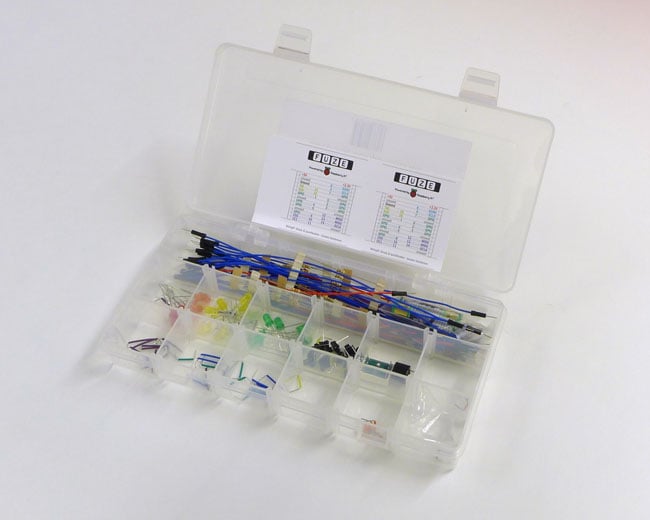
Components included!
And it’s a bit daft, I think, to have a large casing that’s able to present just one USB port. It wouldn’t have been hard to integrate a powered USB hub of sufficient welly to drive some extra USB ports and the Pi itself, not least because the micro USB power feed is the Pi’s one weakness.
Of course, the established Pi users has all this gear anyway, so nostalgia aside, there’s not much to the Fuze for them. Better, then, to think of it as a modern computing or electronics kit you can present to a nipper or eager-to-learn adult newbie for Christmas. Or as a great way to put the Pi safely into schools. ®